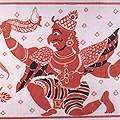In Jammu and Kashmir, the Fateh Kandal area is known for copper vessels. Milk containers and cooking pots are made here along with ladles with long handles, samovars for tea, hukka bases, water jugs or aftabas, and ornamented glasses. The artisans are known for their excellent craftsmanship. The Buddhist blacksmith community of Ladakh is involved in brass and iron work; one of the main items being made are the kitchen stoves called thap chabrik. Attractively ornamented locks and keys are also made. In a village called Chilling in the Zanskar area of Ladakh, silver, brass, and copper is found in abundance. Silver engraving is done to embellish the products made here. Tea kettles, lids for tea bowls, and copper ladles are also made by the silversmiths or sergars. The copper and brass prayer wheels embellished with silver are made by sergars, who also fashion cooking vessels, water jugs, tea pots, chhang pots, bowls, ladles, and tea bowl covers. In Ladakh, the blacksmith community of gara makes iron stoves, locks, keys, and conch bangles. The iron stoves are elaborately decorated with brass strips cut into traditional designs of religious and auspicious significance. These blacksmiths also move from house to house with their tools, repairing old metal objects or galvanising them, and installing large iron stoves, complete with ovens, grills, and ashtrays, with brass ornamentation. They also manufacture agricultural implements and uniquely designed locks. Decorative designs commonly used by the gara include dragons facing each other, druk khabrel, floral strips, and tanka similar to those found on old Chinese coins. Jammu’s most typical and traditional metal craft is the casting of large vessels especially those used for cooking during weddings and other festive occasions. Copper still remains the most popular metal for household use in Kashmir and the most common items are the lota, samovar, and tram. Kashmir also has some beautiful silver work with patterns like the chinar and lotus leaf. The production of a silver object involves three stages — preparation, engraving and cleaning, and finally, gilding. The different people involved in the various production processes are the khar or smith, naqash or engraver, zarcob or gilder, roshangar or polisher and charakgar or cleaner. In Kashmir, enamelling is done on silver, copper, and brass by fusing various mineral substances.
Gallery
YOUR VIEWS
PRACTITIONERS: INDIA
Access 70,000+ practitioners in 2500+ crafts across India.
BIBLIOGRAPHY
10,000+ listings on arts, crafts, design, heritage, culture etc.
GLOSSARY
Rich and often unfamiliar vocabulary of crafts and textiles.
SHOP at India InCH
Needs to be written.






